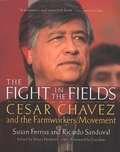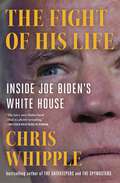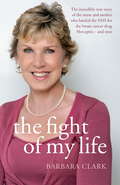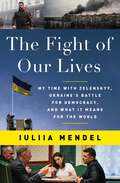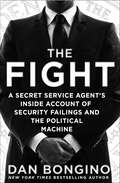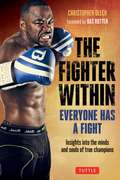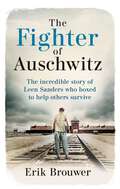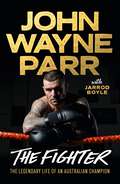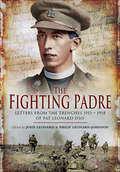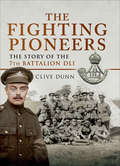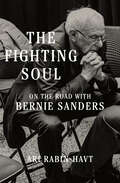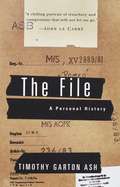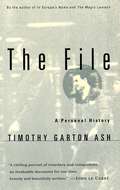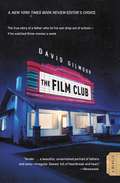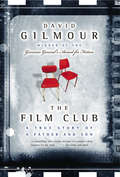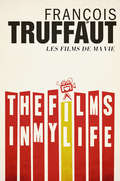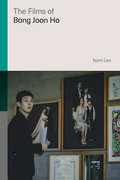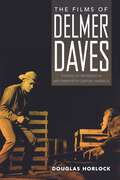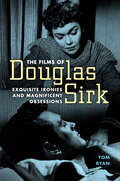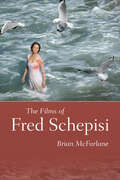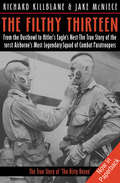- Table View
- List View
The Fight in the Fields
by Susan Ferriss Ricardo SandovalA "vivid, well-documented account of the farmworkers movement"(Philadelphia Inquirer) and its prime mover, Cesar Chavez. Edited by Diana Hembree with a foreword by Gary Soto and essays by Carey McWilliams, Victor Villaseñor, Alfredo Véa, Jr., Peter Matthiessen, Rudolfo Anaya, and others. Black-and-white photographs throughout.
The Fight of His Life: Inside Joe Biden's White House
by Chris WhippleFrom the New York Times bestselling author of The Gatekeepers comes a revelatory, news-making look at how President Joe Biden and his seasoned team have battled to achieve their agenda—based on the author&’s extraordinary access to the White House during two years of crises at home and abroad.In January of 2021, the Biden administration inherited the most daunting array of challenges since FDR&’s presidency: a lethal pandemic, a plummeting economy, an unresolved twenty-year war, and the aftermath of an attack on the Capitol that polarized the country. Waves of crises followed, including the fallout from a divisive Supreme Court, raging inflation, and Vladimir Putin&’s unprovoked invasion of Ukraine. Now, in The Fight of His Life, prizewinning journalist Chris Whipple takes us inside the Oval Office as the critical decisions of Biden&’s presidency are being made. With remarkable access to both President Biden and his inner circle—including Chief of Staff Ron Klain, Secretary of State Antony Blinken, and CIA Director William Burns—Whipple pulls back the curtain on the internal power struggles and back-room compromises. Featuring shocking new details about how renegade Trump officials enabled the transfer of power, which key staffers really make the White House run (it&’s probably not who you think), why Joe Biden no longer speaks freely around his security detail, and what he really thinks of Vice President Kamala Harris, the press, and living in the White House, The Fight of His Life delivers a stunning portrait of politics on the edge.
The Fight of My Life
by Barbara ClarkBarbara Clark is a former nurse, foster carer and mother of two children, one with special needs, and was diagnosed with an aggressive form of breast cancer in February 2005. During her treatment, she found that there was a drug existing, Herceptin, that would double survival chances for her particular form of cancer from 14%. However, it wasn't available on the NHS and therefore, for Barbara, unaffordable. In the midst of aggressive chemotherapy, Barbara, incredibly, found the strength to fight not just the NHS but the government, and to win the right to be prescribed the drug on the NHS, not just for herself but for thousands of other women. THE FIGHT OF MY LIFE will tell the story behind those headlines. It will tell how she first found her cancer, and what it was that gave her the will to battle on and take on, not just the disease but the authorities who were prepared to let her die for want of a drug. Barbara's reasons for living are her three children, two of whom she fosters and who have special needs: their stories and how they dealt with her cancer will also be central to this an amazing, uplifting, inspiring book. Herceptin has treated Barbara's cancer, but it doesn't guarantee a complete cure - rather, it buys her more time to care for the people who are most precious to her, to help other women and to pursue what she calls her 'passion for life'. THE FIGHT OF MY LIFE is the story of an extraordinary woman and of great human courage in the face of despair.
The Fight of Our Lives: My Time with Zelenskyy, Ukraine's Battle for Democracy, and What It Means for the World
by Iuliia Mendel&“Moving.&” —The Washington Post When Ukrainian journalist Iuliia Mendel got the call she had been hired to work for President Volodymyr Zelenskyy, she had no idea what was to come.In this frank and moving inside account, Zelenskyy&’s former press secretary tells the story of his improbable rise from popular comedian to the president of Ukraine. Mendel had a front row seat to many of the key events preceding the 2022 Russian invasion. From attending meetings between Zelenskyy and Putin and other European leaders, visiting the front lines in Donbas, to fielding press inquiries after the infamous phone calls between Donald Trump and Zelenskyy that led to Trump&’s first impeachment. Mendel saw firsthand Zelenskyy&’s efforts to transform his country from a poor, backward Soviet state into a vibrant, prosperous European democracy. Mendel sheds light on the massive economic problems facing Ukraine and the entrenched corrupt oligarchs in league with Russia. She witnessed the Kremlin&’s repeated attacks to discredit Zelenskyy through disinformation and an army of bots and trolls. Woven into her account are details about her own life as a member of Zelenskyy&’s new Ukraine. Written with the sound of Russian bombs and exploding shells in the background, Mendel details life lived under Russian siege in 2022. She says goodbye to her fiancé who joins the front lines, like so many other Ukrainian men. Throughout this story of Zelenskyy, Ukraine, and its extraordinary people, Iuliia Mendel reminds us of the paramount importance of truth and human values, especially in these darkest of times.
The Fight of my Life
by Barbara ClarkBarbara Clark is a former nurse, foster carer and mother of two children, one with special needs, and was diagnosed with an aggressive form of breast cancer in February 2005. During her treatment, she found that there was a drug existing, Herceptin, that would double survival chances for her particular form of cancer from 14%. However, it wasn't available on the NHS and therefore, for Barbara, unaffordable. In the midst of aggressive chemotherapy, Barbara, incredibly, found the strength to fight not just the NHS but the government, and to win the right to be prescribed the drug on the NHS, not just for herself but for thousands of other women. THE FIGHT OF MY LIFE will tell the story behind those headlines. It will tell how she first found her cancer, and what it was that gave her the will to battle on and take on, not just the disease but the authorities who were prepared to let her die for want of a drug. Barbara's reasons for living are her three children, two of whom she fosters and who have special needs: their stories and how they dealt with her cancer will also be central to this an amazing, uplifting, inspiring book. Herceptin has treated Barbara's cancer, but it doesn't guarantee a complete cure - rather, it buys her more time to care for the people who are most precious to her, to help other women and to pursue what she calls her 'passion for life'. THE FIGHT OF MY LIFE is the story of an extraordinary woman and of great human courage in the face of despair.
The Fight: A Secret Service Agent's Inside Account of Security Failings and the Political Machine
by Dan BonginoNew York Times Bestseller: The popular radio host and former Secret Service agent reveals how leadership and security failures have endangered Americans.In The Fight, Dan Bongino picks up the story where his New York Times–bestselling book Life Inside the Bubble ends, tackling important political and security issues and offering new solutions. From Hillary’s emails to the security failings at the White House (including the drone crash and the fence jumper), from Charlie Hebdo to Bowe Bergdahl, the author examines how our government has allowed our security efforts to lapse both at home and abroad. He also offers solutions to the growing terrorist threat and how we can protect American citizens while also deconstructing what’s wrong with our political process and what his experience running for office has taught him.As a former member of the elite Presidential Protection Division who served three presidents, Bongino is uniquely qualified to provide a view from behind the curtain to warn readers about the political system that is failing them, and the security future that won’t protect them. The majority of Americans only come into contact with security when they fly or enter their workplace. They are rarely able to become acquainted with the politicians they know from robocalls and TV ads. Bongino has experienced the inner workings of the national security apparatus and the failed political theater that we all feel but rarely understand. Using a mix of recent events, an insider’s analysis, and tales from his time protecting the president, he shows where clear and foreseeable leadership failures led to grave consequences. From a broken political process to a government that consistently misreads the American people, he shows us where America has gone wrong and how we can fight back.“The Fight shines a much-needed light on the troubling games DC politicians and insiders play with the American people.” —Sean Hannity“The Fight is a lesson plan for fighting back against the Washington DC political machine.” —Mark Levin
The Fighter Within
by Christopher OlechEnter the minds of some of the martial arts world's most respected fighters and trainers. The Fighter Within is an inspirational book for Mixed Martial Arts fans which brings insider stories, heartfelt moments and the human element to what's perceived as a savage sport. It reveals thoughtful, encouraging and even lighthearted insights into the minds and souls of true champions. It describes the attributes that lead to success in a sport that demands dedication, forethought and intellect--traits which are applicable to all of life's challenges. A foreword by Bas Rutten--UFC Heavyweight Champion and three-time King of Pancrase World Champion--sets the tone for this book, which features an impressive array of interviews with a veritable who's-who of elite MMA fighters and martial artists: Fedor Emelianenko (Former MMA Heavyweight Champion and FIAS World Combat Sambo Heavyweight Champion) Rashad Evans (Heavyweight winner of The Ultimate Fighter 2/Former UFC Light Heavyweight Champion) Rich Franklin (Former UFC Middleweight Champion) Rory MacDonald (Former King of the Cage Lightweight Champion Sean Sherk (Former UFC Lightweight Champion) Tomasz Adamek (Boxing Champion) Firas Zahabi (Tri-Star Elite Coach) Bruno Fernandes (Founder of Gracie Barra Montreal BJJ school/President of GB Wear) John Danaher (BJJ Black Belt Elite Coach) Ajarn Phil Nurse (Muay Thai Champion/Elite Coach) Alain Moussi (Actor/Stuntman) Rafal Chwalek (Polish Kickboxing and Savate Champion) Scott Ramsdell (API Head Instructor) Matthew Olson (API Head Instructor)
The Fighter of Auschwitz: The incredible true story of Leen Sanders who boxed to help others survive
by Erik Brouwer'He had the dream again last night... He taps the gloves of his unbeaten Polish opponent. There are rumours that the loser will be sent to the gas chamber.'In 1943, the Dutch champion boxer, Leen Sanders, was sent to Auschwitz. His wife and children were put to death while he was sent 'to the left' with the others who were fit enough for labour. Recognised by an SS officer, he was earmarked for a 'privileged' post in the kitchens in exchange for weekly boxing matches for the entertainment of the Nazi guards. From there, he enacted his resistance to their limitless cruelty.With great risk and danger to his own life, Leen stole, concealed and smuggled food and clothing from SS nursing units for years to alleviate the unbearable suffering of the prisoners in need. He also regularly supplied extra food to the Dutch women in Dr. Mengele's experiment, Block 10. To his fellow Jews in the camp, he acted as a rescuer, leader and role model, defending them even on their bitter death march to Dachau towards the end of the war.A story of astonishing resilience and compassion, The Fighter of Auschwitz is a testament to the endurance of humanity in the face of extraordinary evil.
The Fighter of Auschwitz: The incredible true story of Leen Sanders who boxed to help others survive
by Erik Brouwer'He had the dream again last night... He taps the gloves of his unbeaten Polish opponent. There are rumours that the loser will be sent to the gas chamber.'In 1943, the Dutch champion boxer, Leen Sanders, was sent to Auschwitz. His wife and children were put to death while he was sent 'to the left' with the others who were fit enough for labour. Recognised by an SS officer, he was earmarked for a 'privileged' post in the kitchens in exchange for weekly boxing matches for the entertainment of the Nazi guards. From there, he enacted his resistance to their limitless cruelty.With great risk and danger to his own life, Leen stole, concealed and smuggled food and clothing from SS nursing units for years to alleviate the unbearable suffering of the prisoners in need. He also regularly supplied extra food to the Dutch women in Dr. Mengele's experiment, Block 10. To his fellow Jews in the camp, he acted as a rescuer, leader and role model, defending them even on their bitter death march to Dachau towards the end of the war.A story of astonishing resilience and compassion, The Fighter of Auschwitz is a testament to the endurance of humanity in the face of extraordinary evil.
The Fighter: The Legendary Life of an Australian Champion
by 'John' Wayne Parr Jarrod BoyleThe Fighter is the compelling life story of Australian Muay Thai legend 'John' Wayne Parr - a fighter's odyssey full of twists, turns, world titles, personal challenges and triumphs.Hailed as a legend in the fighting world, ten-time Muay Thai and kickboxing world champion 'John' Wayne Parr knew ever since The Karate Kid came out that he wanted to learn a martial art.From then, Wayne trained in diverse styles including taekwondo and kickboxing as his family moved around Australia. He eventually settled on Muay Thai, seduced by its paradox of violence balanced against the romance of tradition and culture.Muay Thai took Wayne around the world in a career that spanned almost 150 fights. And there were triumphs beyond his multiple wins too, like meeting his wife and starting a family. But amid the thrills of achieving championship status, Wayne also faced challenges brought on by taking his body to the very edge, as well as a series of personal struggles.This is the story of a man who knows what it is to test himself, physically and mentally, and the life lessons he learnt along the way, all told with Wayne's characteristic sense of humour.
The Fighting Frenchman: Minnesota’s Boxing Legend Scott LeDoux
by Paul LevyScott LeDoux&’s face read like a roadmap of boxing&’s last golden era—eye thumbed by Larry Holmes, brow gashed by Mike Tyson, ears stung by none other than Muhammad Ali. &“George Foreman hit me so hard,&” LeDoux said, &“my ancestors in France felt it.&” The only man to step into the ring with eleven heavyweight champions, LeDoux also fought through two of boxing&’s greatest scandals, recurring illness, and childhood trauma that haunted him for decades. This is his story, the life and times of a Minnesota Rocky making the most of the hard knocks that bruise the American Dream, told in full for the first time by award-winning journalist Paul Levy.He was never a world champion, but Scott LeDoux was always the people&’s champ. Doing his best to turn a small-town miner&’s son into boxing&’s next great white hope, Don King said of Scott LeDoux: &“He eats rusty nails for breakfast, punches holes in concrete with either hand, bobs and weaves like a giant Rocky Marciano.&” He was a big, good-natured kid, with a ready wit and the will to take all comers along on a ride he himself found hard to believe. From the mining community of Crosby, Minnesota, to the dingy, mildew-scented dressing rooms in minor-league towns like Sioux Falls and Billings, to the stage of Madison Square Garden, Levy gives us a real sense of what it was like to spar with fighters such as Tyson and Ali. The buried secrets of childhood abuse and the harrowing sadness of death and disease in his family make LeDoux&’s triumphs and defeats all the more poignant and, in Levy&’s irresistible narrative, unforgettable.
The Fighting Padre: Pat Leonard's Letters From the Trenches, 1915–1918
by John Leonard Philip Leonard-JohnsonPat Leonard served throughout the Great War as a Chaplain to the Forces in France, Belgium and, after the Armistice, in Germany. Along with the many hundreds of letters he wrote to the relatives of those parishioners who died or were wounded, he found time to describe for his parents back at home the awful reality of life in the Trenches, and on the makeshift aerodromes from which the pilots of the Royal Flying Corps operated from the Observers seat which liberated his spirit from the mud of Flanders. Very much a front-line priest, his descriptions provide an unusually objective view of army life, and of the job of the multitasked chaplain who was expected to undertake the roles of counselor, comforter, caterer, censor, entertainment officer and sports supreme to name but a few. The extracts selected from his letters are full of detail, humor, self deprecation and just sometimes when judged by todays standards, mild political incorrectness! Known as a veritable fighting parson (because of his prowess in the boxing ring) he also played rugby for the RAF, was mentioned in dispatches, and was decorated for bravery. 90 years have passed before this opportunity arises to share his account of a life which the world remembers as dreadful beyond belief. Reading it demonstrates that despite the ghastliness, human qualities emerged with which we should all be proud. Pat Leonard was born in 1889 into a clergy family in Cumbria, MPG (Pat) Leonard went from being Head of School at Rossall to Oriel College, Oxford on a mathematics scholarship. After graduating and obtaining a TA Commission in the Kings Own Royal Lancaster Regiment, Leonard served as a curate in a Manchester parish before being accepted as Chaplain to the 8th Battalion, the Kings Own, from September 1915 in the battlefields of the Somme Awarded the DSO for bravery and mentioned in dispatches, he transferred to the RFC in early 1918. After the war he was much involved in the development and growth of TocH throughout the world. Subsequently after a period as Rector of Hatfield and ten years in Glasgow as Provost of St. Marys Cathedral he was consecrated Bishop of Thetford in 1953.
The Fighting Pioneers: The Story of the 7th Battalion DLI
by Clive DunnStory of the 7th Battalion Durham Light Infantry. With the creation of the Territorial Force in 1908 the battalion was re-designated as the 7th Battalion. It went to France in April 1915 with the rest of the Northumbrian Division seeing action almost immediately at the Second battle of Ypres. In November 1915 the battalion was picked to become the divisional pioneers. The 1/7 Battalion suffered 600 fatalities. In 1920 when the Territorial Army was reformed it was re-raised in its original role as infantry. The story concludes on 10 December 1936 when the 7th Battalion Durham Light Infantry became the 47th (Durham Light Infantry) A.A. Battalion R.E. (T.A.), whose personnel went on to serve in the Second World War.
The Fighting Soul: On the Road with Bernie Sanders
by Ari Rabin-HavtAn unparalleled and intimate account of Bernie Sanders from one of his most trusted confidants. Bernie Sanders inspires fervent love and, even among his enemies, a measure of grudging respect—yet, curiously, we know little about who the man really is, with Sanders deliberately keeping the focus on his policies. Now, with The Fighting Soul, Ari Rabin-Havt takes us where no profiles or televised interviews have been able to go. As a close advisor and deputy campaign manager on Sanders’s most recent—and likely last—presidential campaign, the tireless Rabin-Havt spent more hours between 2017 and 2020 with the Vermont senator than anyone else. Traveling the country for rallies and to support striking workers, the two visited thirty-six states, drove tens of thousands of miles, and ate in countless chain restaurants. One result was a meteoric and galvanizing presidential campaign. Another is The Fighting Soul, an unforgettable chronicle of life on the road with Sanders and the first in-depth portrait of this fiercely independent, and famously private, left-wing firebrand. Sanders’s second bid for the presidency began in Rabin-Havt’s apartment in Washington DC in January 2018. From there, Rabin-Havt offers a behind-the-scenes account of Sanders’s run, including his heart attack in Las Vegas, his notorious debate encounter with fellow-progressive Elizabeth Warren, and a momentous conversation between Sanders and Barack Obama that has never been reported before. At every step, Rabin-Havt shows us Bernie Sanders when the cameras turn off: his dry sense of humor; his views of his young supporters; the pivotal role his wife, Jane, plays in every decision he makes; and more. Delving into Sanders’s life and career, with moving glimpses of his childhood in Brooklyn and first forays into politics in Burlington, Rabin-Havt discloses that Sanders is shocked by his ascent: “Ari, my parents would tell me I was crazy if I told them I would become a senator, much less could become president of the United States.” Though his campaign ended in abrupt and unexpected defeat, Sanders has pushed the Democratic Party to the left and helped remake American politics—as Rabin-Havt suggests, he has done more to shape our history than anyone else who has not reached the White House. Revelatory and heartfelt, The Fighting Soul depicts the rare politician motivated by principle, not power.
The File: A Personal History
by Timothy Garton AshIn 1978, fresh out of Oxford, Timothy Garton Ash set out for Berlin to see what he could learn from the divided city about freedom and despotism. As he moved from west to east - from Berlin glamour to Berlin danger - the East German secret police, the so-called Stasi, was compiling a secret file on his activities, monitoring his Berlin days and nights and tracking his growing involvement with the Solidarity movement in Poland. Fifteen years later, with the wall torn down and Berlin now unified, Garton Ash visited Stasi headquarters to find his file. The thick dossier he was given forms the basis for this real-life thriller in which he traces and confronts the German friends and acquaintances who informed on him, and the officers who hired them. Behind Stasi reports of suspicious meetings we discover the love affairs, friendships, and formative intellectual encounters that actually occurred. And behind a baffling web of lies, half-truths, and forgotten stories we find a forty-year-old man spying on his younger self.
The File: A Personal History
by Timothy Garton Ash"Eloquent, aware and scrupulous . . . a rich and instructive examination of the Cold War past." --The New York TimesIn 1978 a romantic young Englishman took up residence in Berlin to see what that divided city could teach him about tyranny and freedom. Fifteen years later Timothy Garton Ash--who was by then famous for his reportage of the downfall of communism in Central Europe--returned. This time he had come to look at a file that bore the code-name "Romeo." The file had been compiled by the Stasi, the East German secret police, with the assistance of dozens of informers. And it contained a meticulous record of Garton Ash's earlier life in Berlin. In this memoir, Garton Ash describes what it was like to rediscover his younger self through the eyes of the Stasi, and then to go on to confront those who actually informed against him to the secret police. Moving from document to remembrance, from the offices of British intelligence to the living rooms of retired Stasi officers, The File is a personal narrative as gripping, as disquieting, and as morally provocative as any fiction by George Orwell or Graham Greene. And it is all true."In this painstaking, powerful unmasking of evil, the wretched face of tyranny is revealed." --Philadelphia Inquirer
The Film Club: A Memoir
by David Gilmour"I loved David Gilmour's sleek, potent little memoir, The Film Club. It's so, so wise in the ways of fathers and sons, of movies and movie-goers, of love and loss." --- Richard Russo, Pulitzer Prize winning author of Empire Falls "If all sons had dads like David Gilmour, then Oedipus would be a forgotten legend and Father's Day would be a worldwide film festival."--Sean Wilsey, author of Oh the Glory of It All"David Gilmour is a very unlikely moral guidance counselor: he's broke, more or less unemployed and has two children by two different women. Yet when it looks as though his teenage son is about to go off the rails, he reaches out to him through the only subject he knows anything about: the movies. The result is an object lesson in how fathers should talk to their sons." --Toby Young, author of How to Lose Friends & Alienate People At the start of this brilliantly unconventional family memoir, David Gilmour is an unemployed movie critic trying to convince his fifteen-year-old son Jesse to do his homework. When he realizes Jesse is beginning to view learning as a loathsome chore, he offers his son an unconventional deal: Jesse could drop out of school, not work, not pay rent - but he must watch three movies a week of his father's choosing. Week by week, side by side, father and son watched everything from True Romance to Rosemary's Baby to Showgirls, and films by Akira Kurosawa, Martin Scorsese, Brian DePalma, Billy Wilder, among others. The movies got them talking about Jesse's life and his own romantic dramas, with mercurial girlfriends, heart-wrenching breakups, and the kind of obsessive yearning usually seen only in movies. Through their film club, father and son discussed girls, music, work, drugs, money, love, and friendship - and their own lives changed in surprising ways.
The Film Club: A True Story of a Father and a Son
by David GilmourFrom the 2005 winner of the Governor-General’s Award for Fiction and the former national film critic for CBC television comes a delightful and absorbing book about the agonies and joys of home-schooling a beloved son. Written in the spare elegant style he is known for, The Film Club is the true story about David Gilmour’s decision to let his 15-year-old son drop out of high school on the condition that the boy agrees to watch three films a week with him. The book examines how those pivotal years changed both their lives. From French New Wave, Kurosawa, and New German cinema, to De Palma, film noir, Cronenberg and Billy Wilder, among many others from world cinema, we read about key moments in each film, as the author teaches his son about life and the vagaries of growing up through the power of the movies. Replete with page-turning descriptions of scenes and actors and directors, the narrative is framed with the tender story of his son’s first bittersweet first loves. This is a charming and poignant story about a very special time in a father and son’s relationship. David Gilmour is a novelist who has earned critical praise from literary figures as diverse as William Burroughs and Northrop Frye, and from publications as different as the New York Times to People magazine. The author of six novels, he also hosted the award-winning Gilmour on the Arts. He lives in Toronto with his wife Tina Gladstone.
The Films in My Life
by François TruffautFrom a cinematic grand master, “one of the most readable books of movie criticism, and one of the most instructive” (American Film Institute). An icon. A rebel. A legend. The films of François Truffaut defined an exhilarating new form of cinema for moviegoers the world over. But before Truffaut became a great director, he was a critic who stood at the vanguard, pioneering an innovative way to view movies and to write about the cinematic arts. Now, for the first time in eBook, the legendary director shares his own words, as one of the most influential filmmakers of all time examines the art of movie-making through engaging and deeply personal reviews about the movies he loves. Truffaut writes extensively about his heroes, from Hitchcock to Welles, Chaplin to Renoir, Buñuel to Bergman, Clouzot to Cocteau, Capra to Hawks, Guitry to Fellini, sharing analysis and insight as to what made them film legends, and how their work led Truffaut and his fellow directors into classics like The 400 Blows, Jules and Jim, and the French New Wave movement. Articulate and candid, The Films in My Life is for everyone who has sat in a dark movie theater and dreamed. “Truffaut brings the same intelligence and grace to the printed page that he projects onto the screen. The Films in My Life provides a rare knowledgeable look at movies and moviemaking.” —Newsday
The Films of Bong Joon Ho (Global Film Directors)
by Nam LeeBong Joon Ho won the Oscar® for Best Director for Parasite (2019), which also won Best Picture, the first foreign film to do so, and two other Academy Awards. Parasite was the first Korean film to win the Palme d’Or at Cannes. These achievements mark a new career peak for the director, who first achieved wide international acclaim with 2006’s monster movie The Host and whose forays into English-language film with Snowpiercer (2013) and Okja (2017) brought him further recognition. As this timely book reveals, even as Bong Joon Ho has emerged as an internationally known director, his films still engage with distinctly Korean social and political contexts that may elude many Western viewers. The Films of Bong Joon Ho demonstrates how he hybridizes Hollywood conventions with local realities in order to create a cinema that foregrounds the absurd cultural anomie Koreans have experienced in tandem with their rapid economic development. Film critic and scholar Nam Lee explores how Bong subverts the structures of the genres he works within, from the crime thriller to the sci-fi film, in order to be truthful to Korean realities that often deny the reassurances of the happy Hollywood ending. With detailed readings of Bong’s films from Barking Dogs Never Bite (2000) through Parasite (2019), the book will give readers a new appreciation of this world-class cinematic talent.
The Films of Delmer Daves: Visions of Progress in Mid-Twentieth-Century America
by Douglas HorlockDelmer Daves (1904–1977) was an American screenwriter, director, and producer known for his dramas and Western adventures, most notably Broken Arrow and 3:10 to Yuma. Despite the popularity of his films, there has been little serious examination of Daves’s work. Filmmaker Bertrand Tavernier has called Daves the most forgotten of American directors, and to date no scholarly monograph has focused on his work.In The Films of Delmer Daves: Visions of Progress in Mid-Twentieth-Century America, author Douglas Horlock contends that the director’s work warrants sustained scholarly attention. Examining all of Daves’s films, as well as his screenplays, scripts that were not filmed, and personal papers, Horlock argues that Daves was a serious, distinctive, and enlightened filmmaker whose work confronts the general conservatism of Hollywood in the mid-twentieth century. Horlock considers Daves’s films through the lenses of political and social values, race and civil rights, and gender and sexuality. Ultimately, Horlock suggests that Daves’s work—through its examination of bigotry and irrational fear and depiction of institutional and personal morality and freedom—presents a consistent, innovative, and progressive vision of America.
The Films of Denys Arcand (Global Film Directors)
by Jim LeachDenys Arcand is best known outside Canada for three films that were nominated for Academy Awards for Best Foreign-Language Film: The Decline of the American Empire (1986), Jesus of Montreal (1989), and The Barbarian Invasions (2003), the last of which won the Award. Yet Arcand has been making films since the early 1960s. When he started making films, Quebec was rapidly transforming from a relatively homogeneous community, united by its Catholic faith and French language and culture, into a more fragmented modern society. The Films of Denys Arcand sheds light on how Arcand addressed the impact of these changes from the 1960s, when the long-drawn-out debate on Quebec's possible separation from the rest of Canada began, to the present, in which the traditional cultural heritage has been further fragmented by the increasing presence of diasporic communities. His career and films offer an ideal case study for exploring the contradictions and tensions that have shaped Quebec cinema and culture in a period of increasing globalization and technological change.
The Films of Douglas Sirk: Exquisite Ironies and Magnificent Obsessions
by Tom RyanBest known for powerful 1950s melodramas like All That Heaven Allows, Written on the Wind, The Tarnished Angels, and Imitation of Life, Douglas Sirk (1897–1987) brought to all his work a distinctive style that led to his reputation as one of twentieth-century film’s great directors. Sirk worked in Europe during the 1930s, mainly for Germany’s UFA studios, and then in America in the 1940s and ’50s. The Films of Douglas Sirk: Exquisite Ironies and Magnificent Obsessions provides an overview of his entire career, including Sirk’s work on musicals, comedies, thrillers, war movies, and westerns. One of the great ironists of the cinema, Sirk believed rules were there to be broken. Whether defying the decrees of Nazi authorities trying to turn film into propaganda or arguing with studios that insisted characters’ problems should always be solved and that endings should always restore order, what Sirk called “emergency exits” for audiences, Sirk always fought for his vision. Offering fresh insights into all of the director’s films and situating them in the culture of their times, critic Tom Ryan also incorporates extensive interview material drawn from a variety of sources, including his own conversations with the director. Furthermore, his enlightening study undertakes a detailed reconsideration of the generally overlooked novels and plays that served as sources for Sirk’s films, as well as providing a critical survey of previous Sirk commentary, from the time of the director’s “rediscovery” in the late 1960s up to the present day.
The Films of Fred Schepisi
by Brian McFarlaneFred Schepisi is one of the crucial names associated with the revival of the Australian film industry in the 1970s. The Films of Fred Schepisi traces the lead-up to his critical successes in feature filmmaking, via his earlier award-winning success as a producer in advertising commercials in the 1960s and the setting up of his own company. Unlike some directors, he derived from this experience a sure sense of the commercial aspects of filmmaking, as well as its aesthetic considerations. The volume also considers stories of his early education in a Catholic seminary, which he drew on in his semiautobiographical film, The Devil’s Playground, the success of which launched him as an exciting new feature director. The volume expands on Schepisi’s success story to chart his development as a director in demand in other countries, notably in the US and the UK, as well as continuing to make major films in Australia. Brian McFarlane argues that Schepisi’s career is symptomatic of Australian directors who have made their presences felt on the international stage. Whereas other key directors of the Australian film revival, such as Peter Weir and Bruce Beresford, have been the subject of book-length critical studies, Schepisi’s career has not to-date been so explored. McFarlane takes a critical account of Schepisi’s film output—including such standouts as The Chant of Jimmie Blacksmith, Plenty, Roxanne, Six Degrees of Separation, Mr. Baseball, and Last Orders—and he augments analysis with interviews with the director. By discussing the production histories and both critical and popular receptions, McFarlane’s study shines a new light on Schepisi’s work and his rise to prominence in the global film industry.
The Filthy Thirteen: From the Dustbowl to Hitler's Eagle's Nest—The True Story of the 101st Airborne's Most Legendary Squad of Combat Paratroopers
by Richard Killblane Jake McNieceThe true story of the 101st Airborne Division&’s most notorious squad of combat paratroopers—the inspiration for the classic WWII film, The Dirty Dozen. Since World War II, the American public has learned of the exploits of the 101st Airborne Division, the paratroopers who led the Allied invasions into Nazi-held Europe. But within the ranks of the 101st, one unit attained truly legendary status. Known as the Filthy Thirteen, they were the real-life inspiration for The Dirty Dozen. Primarily products of the Dustbowl and the Depression, the Filthy Thirteen became notorious within the elite Screaming Eagles for their hard drinking and savage fighting skills. From D-Day until the end of the war, the squad&’s heart and soul—and its toughest member—was a half Native American soldier named Jake McNiece. McNiece made four combat jumps, was in the forefront of every fight in northern Europe, yet somehow never made the rank of PFC. The Filthy Thirteen offers a vivid group portrait of hardscrabble guys whom any respectable person would be loath to meet in a dark alley: a brawling bunch whose saving grace was that they inflicted more damage on the Germans than on MPs, the English countryside, and their own officers.
